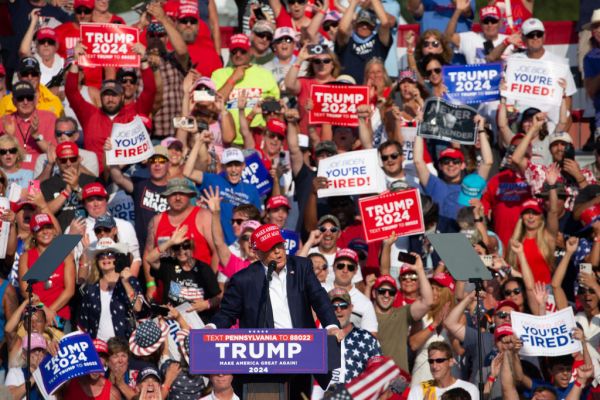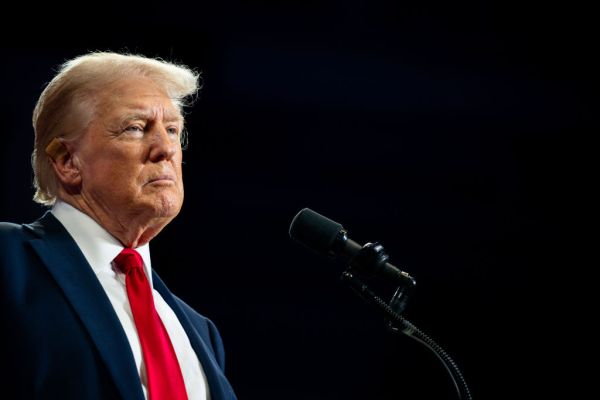Is American politics stupider and more demagogic than it used to be?
It feels that way, but one should always be mindful of one’s intellectual blind spots and suspicious of the “feelings” they induce. Within living memory this country elected segregationists to Congress, Joe McCarthy to the Senate, and Franklin Roosevelt to the White House after he sent more than 100,000 Americans to internment camps because of their race.
Donald Trump is a malevolent clod but don’t let your contempt for him obscure the fact that the field for “stupidest and most demagogic period in U.S. political history” is highly competitive.
All the same, I understand why writers like Damon Linker and Charlie Sykes despair at how silly the right’s reaction has been to a Chinese spy balloon appearing in the sky over Montana last week. The usual suspects did what you’d expect the usual suspects do, as did Ivy League-educated fake populist J.D. Vance—who, I suppose, should probably count as a “usual suspect” at this point.
I wish I could tell you that the inevitable conspiracy theories about China using the balloon to disperse bioweapons were limited to febrile grassroots message boards, but I cannot.
Even the GOP’s more serious foreign policy voices, like the ranking member on the Senate Intelligence Committee, resorted to feeble canned narratives to make sense of the incident.
Joe Biden has warned repeatedly that the U.S. military will defend Taiwan if China attacks. In less than a year the United States has spent $100 billion and counting to aid another ally invaded by an expansionist superpower. Meanwhile, the White House has quietly gotten aggressive with trade policy to disrupt China’s technological development. Given all that, Beijing has no reason to believe America will back down from a confrontation. To the contrary. Yet here was Rubio semi-credulously suggesting that Xi Jinping might plan a generation-defining conflict in the Far East based on how Washington responded to a balloon.
I’m guessing Rubio’s assessment of Biden’s provocative weakness didn’t change when he did ultimately order the balloon shot down once it was safely over the Atlantic.
“The whole response to the balloon thing vividly illustrates how degraded American public life has become,” an exasperated Linker tweeted. “Politicians spouting BS to gain likes and applause online, ordinary people pronouncing on events in utter ignorance and with a total absence of humility. Not good.” Right—but would it have been different in another era? Accusing Democratic presidents of weakness toward foreign aggressors has been GOP SOP since the Cold War started. It got Reagan elected in 1980, George H.W. Bush elected in 1988, and Bush’s son reelected in 2004. Right-wing reaction to the balloon was as predictable as … well, as right-wing reaction to a guy dressed as Satan at the Grammys.
There is something different this time, though. More on that in a bit.
What’s irksome about this episode is that there are interesting questions to be asked and answered about China’s incursion. But thus far Republican leaders would rather have a Sputnik-style freakout about America losing ground to an enemy that allegedly no longer respects its power than to ask them.
Question: Was the balloon over U.S. territory by design or by accident?
One expert on stratospheric balloons told Ars Technica that he suspects an accident, that in all likelihood “the termination mechanism, which is used to bring down a balloon at the end of its desired flight time, failed.” Winter is a strange time of year to spy as well, he noted, since air currents at different altitudes are more uniform than they are during the summer, making it harder to “steer.”
Stranger still, the Chinese must have known that once the balloon became visible from the ground the White House would be obliged to act, creating new problems for Beijing. The remains of the craft might produce a bigger intelligence windfall for the Pentagon than the balloon itself produced for China. And the incursion was sure to jeopardize the upcoming visit by Secretary of State Antony Blinken to repair relations, something China needs to help revive its ailing economy. (Blinken’s visit was ultimately postponed.) Doesn’t that suggest incompetence rather than a deliberate provocation?
Maybe not. Theories are kicking around that the Chinese might have wanted some insight into U.S. air defense capabilities and knew that sending a balloon over would force our air defenses to kick in. Or perhaps there’s a faction of hardliners in Beijing who oppose Blinken’s visit and calculated that some sort of provocation toward the U.S. would force him to cancel his trip. Or, maybe, the Chinese military wanted to gather data to “enhance the accuracy of over-the-horizon and other radar systems used for targeting in wartime” and was willing to sacrifice a balloon toward that end.
The only limit to ChiCom “Kremlinology” is your own imagination.
Question: Was the White House planning to cover up the incursion if the public hadn’t spotted the balloon?
Sure sounds like it. “US authorities were well aware of the unidentified object that had entered American airspace on Jan. 28, that had then left and re-entered over North Idaho on Tuesday,” Bloomberg reported on Friday. “But with [Blinken’s] high-profile trip at stake, keeping it on the down-low was key.” It wasn’t until late in the afternoon of February 2, after news media in Montana began reporting on the strange object in the sky, that the White House came clean.
Sometimes the government has sound diplomatic or national security reasons to keep secrets, weighing that the public interest will be better served by not revealing information than by publicizing it. It’s unnerving, however, to learn that enemy incursions into U.S. airspace are one of those secrets. Perhaps it shouldn’t be: David Frum wrote recently that mutual aerial surveillance by rival powers was favored by the likes of Dwight Eisenhower, who believed that transparency would avert tragic miscalculations that might lead to war. Possibly there’s an “understanding” between the U.S. and China that each can and will spy on the other provided that they’re not too obvious about it. Satellites? Sure. Balloons that are invisible from the ground? Okay. Balloons that are visible from the ground? That’s a red line.
Americans are privileged, though. As the world’s preeminent power, we assume that high-tech overhead surveillance is something we do to others, not something that’s done to us. U.S. territorial sovereignty is sacrosanct—except, it turns out, it isn’t. Suddenly a jittery public is wondering how often this sort of thing happens without them knowing, and with good reason.
Question: Did Trump’s administration cover up incursions as well or is Team Biden distorting the facts to make this latest provocation seem less exceptional?
On Saturday the Pentagon issued a press release about the balloon shootdown containing an intriguing detail. According to a defense official, “Chinese balloons briefly transited the continental United States at least three times during the prior administration.”
A senior administration official confirmed that for Fox News, alleging that “PRC (People’s Republic of China) government surveillance balloons transited the continental U.S. briefly at least three times during the prior administration and once that we know of at the beginning of this administration, but never for this duration of time.” So Trump, the alleged China hawk, also hushed up in the face of Chinese aggression! Liberals stung by the right’s attacks on Biden for not destroying the balloon more quickly exulted that MAGA’s hero had shown as much “weakness” as a Democrat.
But he hadn’t. The same source admitted to Fox that the balloon flights during Trump’s administration went undetected and weren’t discovered until he left office. Several former Trump officials, including Defense Secretary Mark Esper, corroborated that when they said they’d never heard of any Chinese balloon incursions while in office.
That leaves us with two bad possibilities. Either the Trump-era Defense Department wasn’t picking up the balloons at all or they were picking them up but declining to report them up the chain. (Because, perhaps, they feared Trump might respond aggressively?) It also leaves us to wonder why the Pentagon press release this weekend made a point of noting that balloons had entered U.S. airspace during Trump’s presidency without clarifying that those flights weren’t detected until he had left office. Not only did the press release distort the truth, it did so in a way that seemed designed to help Biden do political damage control. Which is not the business the Pentagon is supposed to be in.
All of the above would be fair and thoughtful questions for Republican politicians to raise, as well as more mundane ones like, “Why the hell is China using balloons when they already spy on us with satellites, cutting-edge hacking operations, and TikTok?” (Likely answers: Balloons are cheap, can hover over targeted areas, can take better photos, and are harder to detect on radar. No wonder the Pentagon likes them.) Instead we had members of Congress posing with AR-15s. Why?
I think there’s more to the dimwitted Republican reaction to the balloon incident than partisanship and demagoguery. It’s an attempt to paper over the fact that the party is stuck in an ideological identity crisis that leaves it incapable of addressing complex problems.
That wasn’t as true during the Cold War. Most Republicans then were committed hawks, especially after the rise of Reagan; it was the left, not the right, that contained an unhealthy number of useful idiots for Moscow. When Republicans attacked Democratic presidents for weakness toward communists, they did so in keeping with their ideological beliefs.
In the Trump era, there simply aren’t many consensus ideological beliefs to speak of.
You see it in the new round of debt ceiling brinkmanship. Republicans have no idea what spending they want to cut because they have no sense of what the party is anymore. Does it want a beefy military to project power abroad or should it refocus on domestic problems? Does it still believe entitlements are unsustainable unless reformed or has it accepted the leftist/nationalist consensus that Social Security and Medicare are inviolable unto eternity? There are meaningful constituencies within the GOP on each side so it can’t form serious, coherent spending priorities. If it tries, the infighting will be brutal. The party might fracture.
So it chooses to fight the Democrats instead, which is all the debt ceiling standoff is ultimately about. The point isn’t to take a hostage and ransom it toward a useful end. The point is to take a hostage because the party can at least still unify around the proposition that the libs should be confronted whenever Republicans have the power to do so.
The post-Trump identity crisis extends to foreign policy. Alongside a contingent of old-school hawks, the GOP has a MAGA faction whose preferences are as muddled as their leader’s. Trump wants the country less entangled abroad, demanding that America put America first, yet he’s obsessed with projecting “strength” and is apt to turn around and bomb Syria or assassinate Iran’s top general if the mood strikes.
For reasons I don’t understand, he and many other nationalists seem quite hawkish about defending Taiwan. Typically they tell you that Americans shouldn’t be asked to die for any country but their own, yet they seem ready to make an exception for regional conflict with the world’s most populous country. If and when war with China comes, I suspect populists will end up splitting between true “America Firsters” who oppose intervening and “fighters” who can’t resist responding to aggression by a communist outfit with military strength.
A new Gallup poll about Republican foreign policy divisions is instructive. Asked whether the U.S. has done too much or not enough for Ukraine, 50 percent of GOPers say “not enough” or “the right amount” versus 47 percent who say “too much.” A party as confused and divided as that is treacherous political terrain for its leaders to navigate. So, when a simple and straightforward crisis pops up presenting an opportunity to unify, naturally they’ll lunge at it. That’s the balloon, which was tailor-made for prefab narratives about Biden’s “weakness,” knee-jerk demands to shoot it down now, and moronic photos of senators pointing guns at the sky, the latest reminder that there’s no policy problem populists won’t turn into culture-war performance art.
Plus, let’s face it: The GOP isn’t sending its best. We don’t have many strategic thinkers in Congress nowadays, but we do have a ton of people able and very willing to tweet out thoughts like this.
This is a party led by a con artist who claims to have a secret plan to end the Ukraine war in a day but declines to provide details, yet who nonetheless remains the frontrunner for its presidential nomination. That’s the same guy whose solution to America’s immigration crisis is to build a wall and shoot migrants in the legs. The Trump-era GOP doesn’t do complex problem-solving. In fact, to suggest that problems require complex solutions is apt to get you viewed suspiciously as a squishy egghead who’s dressing up his timidity as sophistication. If you’re willing to be ruthless enough, the thinking goes, any complicated policy dilemma can be resolved simply. Don’t think. Don’t wait. Just shoot it down. Immediately.
On the simplest level, I think the politics around the balloon incident appeal to modern Republicans because they’re familiar. Trump’s movement is built on nostalgia for a lost age of glory—it’s right there in the name—and the 1950s loom large both for him and his supporters. Communist technology floating into U.S. airspace is a very 1950s-style crisis. (A few days ago the Wall Street Journal speculated semi-seriously about an, ahem, “balloon gap.”) The Sputnik analogies are dumb in context but understandable as a cultural reference; popular anxiety that the U.S. will be overtaken by an illiberal rising power is quite real (and not entirely ill-founded). “As it wafted through US skies before being shot down Saturday off of the Carolinas, the balloon created a sudden moment when the idea of a threat by China to the US homeland was neither distant, theoretical, unseen, or years in the future,” wrote Stephen Collinson at CNN, aptly. If you agree with Trump that American prestige is and will forever remain in terminal decline unless feral authoritarians run the federal government, a Chinese spy balloon in the sky over Montana was a rare proof of the theory that you could see with your own two eyes.
In context, it would have been political malpractice for Republicans not to attack Biden over it. But, the modern GOP being what it is, those attacks were destined to be 80 percent more stupid than they had to be.









Please note that we at The Dispatch hold ourselves, our work, and our commenters to a higher standard than other places on the internet. We welcome comments that foster genuine debate or discussion—including comments critical of us or our work—but responses that include ad hominem attacks on fellow Dispatch members or are intended to stoke fear and anger may be moderated.